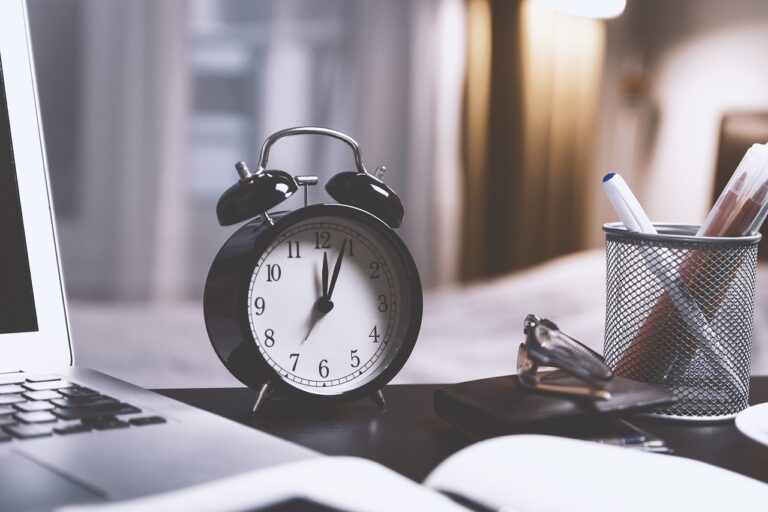How to use your biorhythm, timing, and a distraction list to boost your productivity at work. Productivity at work redefined is in everyone’s mind. Whether it is the employer who wants to become more productive to not feel the pressure of having too much work ahead anymore or a company owner who got a big new deal and needs the team to execute that fast.
Ditch the hustle and Listen to yourself
When it comes to Productivity at work redefined there are easily hundreds of methods and tools out there. Among these, there is the popular method of getting up at 5 am and then working while others still sleep or forcing yourself to not check social media for an entire day. And while these methods are great and even better, congrats if you are using them successfully for some time already, common productivity tools tend to only work for a small number of people– the ones that are very disciplined and have a high internal or external motivation. And if this is not you, you will struggle with productivity for a long time, trying techniques over techniques. For that reason, this article offers an individual approach to productivity where you consider your unique biorhythm, timing, and perfect work environment.
The downside of just going with the flow
Just going with the flow, starting a task when you feel like it, and not caring about productivity because you trust that everything will be fine can impact your mental health negatively. A reason for that is that the mind naturally seeks comfort (or laziness if you want to call it that) and thus is naturally resistant to doing a lot of work, especially if it’s challenging.
If you just go with the flow and only do what you feel motivated to do, you end up in a situation where work is piled up on your desk and you feel the stress of “I need to get all this done”. With that feeling of pressure and overwhelm you will have a hard time relaxing and really switching off during your free time which then leads to mental exhaustion and stress. This then results in less energy for work and thus less productivity. So by not caring about productivity, you are harming your productivity.
Productivity at work redefined for well-being
If you work on your productivity you can learn to use the time at work efficiently and get tasks done in the best and fastest way. This then results in a boost of confidence in the long run as you are entering into what I like to call the “doer mentality”.
The doer mentality is a mentality that is built over time stemming from the discipline to get things done right on time and face challenging tasks right on. This mentality enables you to switch off after work because you know you got everything done for that day. The relaxation you then get in your free time gives you energy again for your workday.
To whatever camp you belong this article offers a new approach to productivity at work redefined. And the approach that is all about
- Knowing your Productivity Type
- Matching your types to the right techniques
- Trying out some Productivity hacks
But before we start, we need to take a little step back and understand what productivity is.
What is productivity
“Productivity is commonly defined as a ratio between the output volume and the volume of inputs.” The word productivity is often used for teams, factories, and even entire countries. In the case of personal productivity, it means the time and energy you put into a task in relation to the outcome you get. You would consider yourself not productive when you put in 5 hours of unfocused work and the result is mediocre v.s you put 3 hours into the same task and the result Is exceptionally good.
Some interesting statistics on productivity
– The average employee is distracted every 3 min. Once distracted it takes 23min to refocus
– 86% of people prefer to work alone
– Average Office Worker Is Productive for Less Than 3 Hours a Day
– Employees who participate in big decisions are more productive
– Employees allowed to work from home once a month are 24% happier
1. Knowing your Productivity Type
Every person is different, not only because of the job title but also because of the biorhythm and attention spans. Furthermore, some people are early birds and some are night owls. For some it’s very hard to get anything done before having breakfast, for others having a heavy meal in the morning is actually taking away their energy. And for that reason, this step helps you discover and understand your unique productivity type so that you can match this type to the methods later on.
How productivity can be improved by your biorhythm
The very first thing you want to understand is your biorhythm and how your personal biorhythm can help you improve productivity. The biorhythm is your unique cycle of functioning which includes sleep and eating habits but in regards to productivity, we focus on your energy levels. When knowing your energy biorhythm, you can better plan important tasks around your high energy hours and less important tasks around lower energy hours. To best understand your unique rhythm, do the following.
For 5-7 days keep an energy diary where you track your energy levels every hour by rating it from 1-5 (5 being the highest).
You can simply do this in a table like this:
| Time | Monday | Tuesday | Wednesday | Thursday | Friday | Average |
| 6 am | 2 | 3 | 1 | 2 | 3 | 2,2 |
| 7 am | 4 | |||||
| … | ||||||
| 10 pm | 2 |
It’s best to immediately start with the waking hour and end with the hour you go to sleep. At the end of the 5-7 days, you calculate the average energy level for every hour to see what on a daily basis is your highest and lowest point.
You may notice that you have a lot of energy in the morning or more at night. This can be later used when planning tasks.
Your ideal working environment
Another aspect of knowing your type is knowing the ideal working environment. Some people work well when listening to music, some need absolute silence to be productive. To explore this, answer the following questions:
- What was/ is my worst working environment? What habits influence my productivity badly?
Crowded places? Sleeping in? A heavy meal? Alcohol? Constant distractions?- What was/is my ideal work environment? What habits influence my productivity positively?
Working with other people? Having 8 hours of sleep? Having my meals planned? Working from home?
After answering these questions as detailed as possible, compare your current working environment to your answers. See if there are any negative factors that you can eliminate and positive factors you can add to your work environment.
In the following, some productivity methods will be explained that can be used based on your productivity type. After that, some hacks will follow that are good practices for productivity at work redefined.
2. Productivity at Work Redefined- Productivity Methods
The right Timing for productivity at work
Productivity is as much about managing your time as cooking pasta is. If you take too long, the pasta is soft. If it’s too short, the pasta is hard and not eatable. Same with your productivity. If you try to focus for too long, you may end up exhausted. Or you may end up producing work with a lot of mistakes because your concentration decreases. On the other hand, if you focus for too little, you may not be able to get into a flow state.
In general, people tend to overestimate the time they can focus and underestimate the time they need to rest. To solve this issue here are some methods to manage your time, starting from short focus times to longer ones.
1. Pomodoro Technique
The pomodoro technique is probably one of the more famous timing methods, for a good reason. The basic technique is a 25-5-minute block that divides your day. 25 minutes of focus time are followed by 5 minutes of rest. This cycle repeats until you take a longer 15-30-minute break. The key of this technique is to define your tasks before each blog and track your progress after each 25minute window.
I personally really like this technique as it is very easy to implement. After trying this technique, you will be impressed how much you can get done in these 25- minute windows. Furthermore, this technique is for tasks that you have a lot of resistance to or for someone, who has a lot of trouble with productivity.
There is also a great productivity timer app that can be used for this technique.
57-17 Technique
Another great way to schedule your time is using 57 minutes of focus time and 17 minutes of rest. This allows you to get more things done and enter into a flow state and then reward yourself with longer rest. Of course, you can switch the times around and find your own focus and break duration. But the key really is to find one time frame and then stick to it.
Now that we covered some timing methods, we can look into task dividing and prioritization.
Dividing and prioritizing your tasks
When you start looking at your productivity, you may notice that you have a lot of tasks and little time to get all of them done. And some tasks are like dark holes that you get lost in as they get bigger and bigger the more you work on them. For that reason, having a way of prioritizing your tasks and matching them to your productivity type, can do wonders.
1,3,5 Blocks
This method allows you to define your tasks into big and small once which then helps to schedule a time and to have a feeling of accomplishment at the end of the day. Basically what you want to do with this method is you want to define
- 1 big task
- 3 medium tasks
- 5 small tasks
for one day and then work on getting them done. Big, medium, and small can be calculated by the time it takes to get these tasks done or by the importance of a task. For example, a big task can be one that takes several hours to complete or one that is very important to get done. The same applies to the medium and small tasks.
Now with this approach, you can work two ways: either you start with the small tasks, which I personally love to do or you start with the big tasks. When looking at these tasks from an importance perspective, it’s good to consider your energy biorhythm as well. When one big task is very important, schedule it into the hours where you have a lot of energy and get the smaller one done at times where you are lower in energy.
The one big thing
Strongly tied to the 1,3,5 Blocks method is the technique of the one big thing. Because your days are filled with to-do’s, finding the one big thing that is really important for your work and then focusing on that before doing anything else, can really improve your productivity. A reason for that is that you manage to simplify things and focus on what is essential for your day. To find your one big thing, ask yourself:
What is the one big thing I want or need to accomplish today that would make a difference in my work? What is one thing, that if I get it done, would create a big improvement or open new possibilities in my work?
When you have an answer, make sure to work on this task while you have the most energy during the day. A step further would be to give away tasks that are not related to your one big thing, if you can.
Blocking Time
The work-day is often filled with meetings and in between them, it can be hard to find some undisturbed focus time to work on your defined tasks. A good solution for that is to calculate the time it takes to complete a task and then block that time in your calendar.
For example, if you use the one big thing method, you can estimate how much time it will take you and then define how long you want to work on that task during the week. For example, preparing a sales presentation may take 4 hours and you decide to work on it on two days for two hours. You can now look at your calendar and block the 2x2h in your calendar for you to work on the task.
After covering the productivity methods, here are a few productivity hacks you can try out for yourself.
3. Productivity at Work Redefined- Productivity Hacks
A way to handle Distractions
A very common negative influencer of productivity is distractions. Anytime you hear the phone ring, check social media or go to a colleague to chat, you are getting distracted. Distractions won’t be so bad if statistics didn’t say that it takes 23min to refocus after getting distracted.
A good productivity hack to handle distractions is to keep a blank sheet of paper next to you whenever you are focusing. If during your focus time a thought or desire for a distraction arises, instead of engaging with it, you just write it down and then continue your work. If you already got ahead of yourself and you automatically checked your phone, stop yourself and write the distraction down as well.
Hold Boredom
One of the reasons you are so susceptible to distractions is that you are constantly busy and never actually resting our minds. Whenever you have a few minutes spare, you check social media for example. This would not be so bad if exactly that behavior negatively influences our productivity.
During focus times, the mind is highly engaged and during rest times, the mind should ideally get a break. The better the relaxation during the break time, the better the focus phase after it. For that reason, practice boredom. Actively, in your breaks, do nothing and rest your mind. Try to sit and calmly observe yourself, not engaging in any specific thought and be present. If you need anything to focus on, focus on your breathing. For that, you can try to Mindfulness Meditation Bundle.
Appointment Scheduling
Oftentimes during work, you need to coordinate with other people and thus have meetings from time to time. If you are not in the position to just schedule a meeting with someone in their calendar, you can use an appointment scheduling like calendly to save yourself the back and forth of “how about Wednesday at 11 am?).
Fewer Emails
Writing several emails, a week to the same person or team can take a lot of time. If things are not urgent, you can collect the information of all these emails and then write one big email and send it out to save time. This does not only help you save time and be more organized but also the other party. A key here is to also keep the wording minimal. Only say what needs to be said besides the usual courtesies.
Act before inspiration and motivation
Sometimes tasks you need to fulfill can be draining and this comes with a lack of motivation in a lot of cases. Then waiting for motivation can lead to procrastination. For that reason, it is great to develop the habit of acting before inspiration or motivation. This is a key element of productivity at work redefined.
Oftentimes motivation and inspiration come in the process of doing something instead of waiting for it. And when you manage to sit down and get a task done, you are more likely to find it.
This is what I like to call the “doer mentality”. This mentality implies that you get into the habit of doing regardless of your state of mind or mood. This doer mentality builds confidence over time and helps to take the lead on your productivity.









